© 1986 Rich Grzesiak, all rights reserved.
Although this feature was written in 1986, it contains some valuable history of gay magazines—and I'm amazed (immodestly?) at how well it holds up in 1997, despite the fact that several periodicals named below, like Christopher Street and In Style for Men, are no longer being published.
So what's your favorite gay magazine? Is it the leather studded world of Drummer? Or the soft, whiter than sunrise blondes of In Touch? Anybody out there dig Inches, Skin, Torso, Mach, First Hand, Manscape 2 or even that severe favorite, Dungeonmaster?
Of course you do. Even the hoi-polloi, the gay literary elite that prides itself on rubbing shoulders with winners of the literary prize, the Prix de Goncourt, can't get enough of the sexy men and the porn stories larded among them in these periodicals.
So come with me, then, for a New Journalism-style tour of the gay magazine world. I should stress straightaway that I am interested in neither academic insight nor Journalistic Truth. Nor do I have any expertise in evaluating lesbian media; frankly, considering the number of lesbians out there, I've never understood why there aren't more general interest lesbian magazines.
This is also not a formal overview destined for a journal of library science, so you will find omissions here based largely on my personal tastes and what is generally available; I will not, for example, be saying much about the very fine but relatively unknown James White Literary Review.
I should also immediately fess up on my prejudices: the best gay magazine should be something on the order of Playboy: a nicely balanced, evenly textured, highly sophisticated mixture of sexy photography, scrumptious models, intelligent entertainment/cultural writing, and superior layout. Sadly, with the possible exception of Drummer [or maybe even Blueboy eight years ago], there are very few winners of that type.
In general, gay magazines reach a vast and loyal readership which, were gay newspapers capable of emulating that service, would have publishers salivating for months on end. There are many, many, many people who, while they would never purchase a copy of Miami's The Weekly News or The New York Native, could not live without the latest ish of, say, In Touch. That's quite an astounding achievement when you consider its implications.
It means, for example, that for many gay [male] readers, their basic contact with gay written culture—even gay politics—probably lies in the centerfolds of these magazines. It would also suggest that in reality the struggle for gay sexual freedom in the United States occurs in the comparatively large circulations of these "skin rags,'' to use an impolite term.
Very frankly, were I a gay politician on the make, I'd be making damn sure I regularly got my mug into the pages of each one of these periodicals. Each in their own way reaches an incredibly influential [some might say "politically untapped"] populace.
There are three other factors I should highlight for readers not in the know.
While I will name no names, it is common knowledge that certain portions of the pornography industry are synonymous with the syndicate in this country (now do you understand why 5 successive presidents have never scored at controlling the mob?).
The second factor which personally saddens me is the outlandish exploitation of not only the writers who toil for this profitable industry, but also the models who sell themselves so cheaply to appear in the pages of these magazines.
The educated observer understands that many of these "models" are in fact little more than male prostitutes interested in shoving their portfolios before a highly consumer-oriented audience. Really: if you were a whore out to make big bucks, would you place a modelling classified in, say, the Pierre, South Dakota Gay Gazette—or would you grant an exclusive photo opportunity to Gentlegay's Quarterly?
I can never ignore those thoughts when reading these periodicals. Nor can I pretend away the chronic drug addiction that afflicts so many of these young Adonises, some of whose narcotic habits would make the late Janis Joplin seem like Little Bo Peep [for more on that subject, see especially Tim Barrus' wonderful short story in Mach, Vol. 3, Issue 10, currently on sale].
But the last—and perhaps the most important—fact of life about gay magazine publishing is the tragic irony that most of these magazines we're about to discuss are not even owned by gay people! As writer T.R. Witomski pointed out recently, "With the exception of Drummer, Dungeonmaster, and Mach, now all in the hands of Tony DeBlase, the gay slicks are all owned (at least partially) by straights, generally as part of larger porn companies."
Witomski overlooks the gay owned ADVOCATE Men and a few other slicks but you might think about that last nugget of wisdom the next time you plunk down a few dollars for some of the er, uh, less glorious of these periodicals.
So, now, on to the meat!
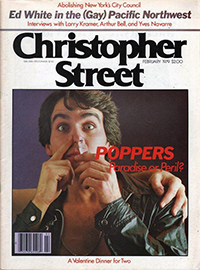
Christopher Street. Monthly. Single issue price $3. $29 for 6 issues. Available from That New Magazine, Inc., P. O. Box 1475, Church Street Station, New York, N.Y. 10008.
This is the magazine that likes to promote itself as the journal that Walt Whitman, Oscar Wilde, Moses, Tchaikovsky, Marx, Buddha, Nureyev and Hermione Gingold might have written for [yeah, if only they got paid; more on that later].
What is the basic concept underlying Christopher Street? That's a long story, but here's the most convincing anecdote I've heard.
About 10 years ago, one Jeffrey Escoffier [now Executive Editor of Socialist Review] organized a lecture series for the then fledgling Gay Community Center of Philadelphia. One of his esteemed invitees was the then young Charles L. ["Chuck"] Ortleb, publisher of Christopher Street.
Now Mr. Ortleb arrived here with his entourage (hairdressers call them "followings") and he proceeded to make a little speech about The Purpose of Christopher Street. According to eyewitnesses, he wanted to create a gay version of The New Yorker.
Several people in the audience were appalled. A gay version of The New Yorker? Ortleb had to be kidding. Surely the magazine that published Truman Capote, Janet Flanner (and eventually even David Leavitt!), etc., didn't need a gay competitor, now, did it?
Anyway, that was the rationale. But seriously, it seemed unconscionable that in the publishing center of the United States there should be no outlet for openly gay writers to reflect on the gay experience.
And the first issues of CS lived up to that promise. There was art, politics, poetry, entertainment, religion, gossip, interviews CS also lay claim to a rabidly witty band of stylists who filled each issue with their own special style.
Then came trouble with a capital "T" [our apologies to the producers of The Music Man for that last sentence]. CS could not attract enough advertising to pay its printer's bills and, needless to say, it couldn't even pay its own writers who provided the bulk of the hard work on which the magazine's lofty reputation relied.
Thus the advent of The New York Native, created "to save Christopher Street." The weekly Native, originally published fortnightly, was supposed to generate enough capital to keep CS from going broke.
CS wasn't saved so much as it was calcified into a very predictable arty format. There's always three pages of house ads testifying to how glorious the magazine is, a short story, some badly mangled features, and Something Serious for Intellectuals to Think About.
In that regard, issue #99 produced a new crackpot AIDS theory from one Ann Giudici Fettner. It was so outlandishly crazy that even the normally staid Philadelphia Gay News branded it as "reprehensible." [Fettner, the Native's medical correspondent, recently got into a public brouhaha with Ortleb over money. Her two-part interview with scientist/AIDS researcher Robert Gallo became the subject of Geoffrey Stokes' media column in The Village Voice when its publication in the Native was interrupted after the first installment, allegedly over problems with payment. The second half of the article eventually did run; Ortleb complained publicly that people mistook him for "Mr. Money Bags"; and, as of mid-October, Fettner's name once again seems to grace the pages of the Native, her problems with Ortleb momentarily resolved. This latest display of Ortleb's mismanagement has brought the credibility of That New Magazine, Inc. to its lowest point in years].
Beyond its predictability, CS's basic problem lies in its provincialism. It just doesn't seem to speak to a broader audience than the art queens who dominate a portion of Manhattan gay life. It also projects an image of itself as the doyen of excellence in gay publishing when, in fact, that image is nothing more than a delicately managed PR exercise in sheer sham.
My advice? Read CS only if you're planning a trip to New York; read it mainly for the rapier wit of Boyd McDonald or the intermittently serious side of Andrew Holleran, a Manhattan expatriate who now makes his home in Florida!
And please, will somebody tell Mr. Ortleb that it might be time to retire CS editor Tom Steele? The magazine could more than benefit from a radical changing of its tired old guard.
It's also about time CS adopted a token fee schedule for paying its writers. This is the twentieth century, you know.
Drummer. Monthly. Single issue price $4.95. Available from Desmodus Inc., P.O. Box 11314, San Francisco 94101-1314.
Dungeonmaster. Published 6 times a year. Single issue price $3.50. Six issue subscription, $15. Available from Desmodus Publications, Inc., Box 6592, Chicago, IL 60680.
Manscape 2. Published quarterly. Single issue price $3.95. Yearly subscription, $15. Available from Manscape 2 Magazine, P.O. Box 1314, Dept. M2, Teaneck, N.J. 07666.
There are few subcultures in the gay community quite as interesting—or vibrant—as the leather world.
There are few subcultures in the gay community quite as interesting—or vibrant—as the leather world. These magazines serve a very fastidious audience, and the fact that there are three exploring the very same subculture should give you some insight into its appeal.
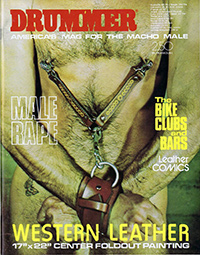
By far the best of the lot, Drummer has been around for about 10 years and boasts one of the most loyal gay readerships; it will soon publish its one hundredth issue. [There are no official figures, but my guess is that Drummer's circulation is somewhere in the 15,000 to 25,000 range. This compares to, say, roughly 9,000 for Christopher Street].
Drummer 's format is fixed: There are usually 3 or 4 fictional stories, a cartoon section ["Drum"] by Bill Ward, fascinating classifieds, Larry Townsend's column on health advice, "Tough Customers" (a photo section exhibiting what the classifieds can't) and usually a multi-installment porno serial, the most famous of which was John Preston's "Looking for Mister Benson"—the current one is a weak entry called "Bound for Glory."
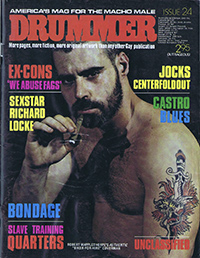
But things may change soon at Drummer, due to the magazine's recent purchase by Tony DeBlase [a/k/a "Fledermaus", the owner of Dungeonmaster. Dungeonmaster really isn't a magazine so much as it is a newsletter for S&M enthusiasts. Its contents focus primarily on the mechanics of S&M; the style is bloodless, humorless and a bit too pedantic even for my severe tastes].
Drummer's recently installed new management lists, curiously, one "JimEd Thompson" [sic] as its new Associate Editor; Thompson is porno star Chris Burns' lover, interestingly. Well-known activist political writer Scott Tucker ["Mr. International Leather, 1986"] has been named a "Contributing Editor," an event which should make for some of the most fascinating, if not controversial writing Drummer has sponsored in years.
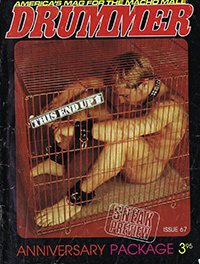
Its Book Editor remains T. R. Witomski, whose bitchily scathing prose has earned the enmity of everyone in gay publishing from Felice Picano to Ethan Mordden. As Drummer approaches its one hundredth edition, there is much promise in the air and many potential problems as it changes.
My basic problem with these three periodicals is that they focus too heavily on entertainment when they should be addressing serious subjects as well. Until recently, only Dungeonmaster [which ran a long article headlined "S&M Is Safe Sex"] seemed to be dealing with the health crisis regularly, a problem which has hit the leather community very, very hard.
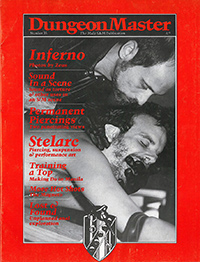
But you'd never sense it from the kinds of articles these magazines run or even some of the pornography they feature. Drummer recently sponsored a debate on the riskiness of poppers as a sexual stimulant and there is the expectation of more sensitive, prominently displayed health coverage in the future there, too.
By contrast, the quarterly Manscape 2 represents the poor man's version of Drummer . M2's cover price is a dollar cheaper; it relies more heavily on photo spreads, and its fiction tends to be shorter and less "literary" than its competitor's.
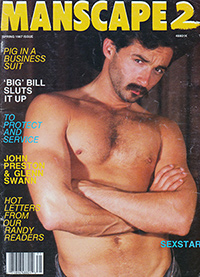
M2's biggest difference is that it tends to pay more outright attention to what its readers want to read, as evidenced by generous excerpts from various reader's accounts of their S&M sex experiences. These letters give the magazine a real world flavor but also detract, given the erratic quality of their prose, from M2's image. The magazine is printed on the same low grade paper stock that First Hand uses but, since M2 pretends to higher standards, it looks worse in the process. The overall effect is mildly erotic yet chintzy.
That criticism, aside, however, these magazines pay attention to what their readers want, else how could they claim the success they do? And there seems to be a regular turnover of personnel at these periodicals (especially at Drummer) which, while it may reflect internal editorial problems, does also work to furnish a constant injection of fresh ideas and new blood. Reading them, one never comes away with the sensation that one is hearing yet again from the same tired old editorial dears.
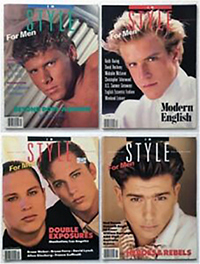
First Hand. Monthly. Single issue price $2.95. Yearly subscription, $33 Available from First Hand, Ltd., 310 Cedar Lane, Teaneck, N.J. 07666.
In Touch. Monthly. Single issue price $3.95. Yearly subscription information available from IN TOUCH FOR MEN, 7216 Varna Avenue, North Hollywood, CA 91605-4186.
In Style for Men. Bimonthly. Single issue price $3.50. Yearly subscription, $14.50, from IN STYLE FOR MEN, 7216 Varna Avenue, North Hollywood, CA 91605-4186.
Style, style, style!
Style, style, style! There are many drugs prevalent in the world of gay publishing, but the one that's most addictive and popular (next to sex) is—style, style, style!
First Hand, In Touch, and In Style for Men all celebrate the best of gay popular culture in sexy, illustrious, handsome ways. If there is such a thing as a guidebook for a sexy gay middle class lifestyle, these three magazines will do just fine.
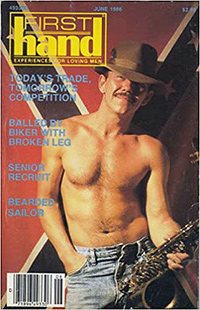
First Hand is probably the only known connection between the new sexy gay writing and many gays themselves. First Hand has had a string of accomplished editors who have helped keep the superb copy editing evident here at a very high level [I'm thinking here of former First Hand editors Brandon Judell and Jack Veasey. When Veasey recently resigned as Editor he wrote to contributors that his departure had nothing to do with "the Meese-induced financial troubles that gay porno can be a voice of reasonable individuality in a world of insane conformity" Veasey's successor is one Lou Thomas].
First Hand is both sexy a and serious, running both a very moving account of the AIDS crisis in San Francisco right next to a hilarious description of a mythical gay cable channel—and finishing the issue out with some finely edited erotica and poetry. First Hand is a first class gay magazine in every sense of the word. But even that editorial excellence is not immune from the winds of political change.
The Meese commission has cut into the potential distribution outlets for magazines like First Hand, and the resulting decline in cash flow has led to "temporary" financial discomforts for writers. First Hand, for example, is now telling some contributors that they are five months in arrears for payment of articles—by contrast, mainstream media pay freelancers in about 30 days from the appearance of their work. If this new censorship persists, I would predict the decline, if not the disappearance of some of the more financially marginal enterprises among these slicks.
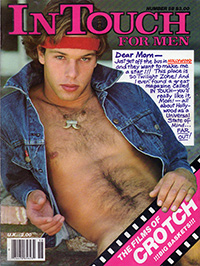
In Touch is slicker, larger [in page size], more colorful, and more of a potpourri of light-hearted content than First Hand tries to be. In some ways, it's like a very sexy gay journal where the primary accent is on fluff and style. Its motto is directly akin to Mad magazine's "What—me be serious?" yet its self-described "sexy models" impress me as being too Californian, too blonde, and far too young.
But does anyone remember a magazine called After Dark? In Touch's sister publication, In Style for Men resembles its lavish layout and packaging. A recent ish evoked the essence of Japan without being tacky, stupid or artsy-craftsy; another took a look at the Brits (called "Modern English"); the next issue looks at "Rebels and Heros."
IS is like a picture book version of Architectural Digest deliberately geared to gay male urban professionals and their checkbooks; it's the kind of non-literary, general interest style guide which Christopher Street pretends to be but never quite realizes.
To the extent that IS provides an outlet for well-paid and well-written manuscripts, I blind my eyes to their endless homage to gay capitalism, and pray that I too may one day tool down Rodeo Drive in my Mercedes with several well-hung men holding my charge cards in a mink-lined valise.
Doesn't everyone?
- Skin
- Inches
- Stallion
- Manscape
- Torso
- Mandate
- Mach
- ADVOCATE Men
- Blueboy
- Honcho
While reading these magazines, I had a terrible problem: not only did purchase of them eat a terrible hole in my pocket [most run a average of $4+, so a good ten of them bilked me of some $40+], but I just couldn't keep them stacked together on my desk. They are literally all so slick that they slide, so very symbolically, right off of each other.
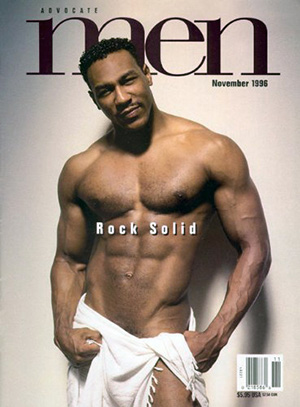
Most are monthly, most seem intimidated by language, all, with the exception of, possibly Mach, ADVOCATE Men, Stallion and Inches, suffer from indifferent editing and an obsession with models so commercial that you almost want to ask, "Where are your belt buckle charge machines? How many dollars per inch?"
(I also refused to purchase some of the downright slimeball scumbag rags, you know, those unmentionable ones whose names reproduce various sex acts, where the models look more intelligent than the editors and the editors, such as they are, must be even more imbecilic than their owner-publishers. And where the display advertising would be enough to make Myra Breckinridge blush).
The best offer at least one interesting celebrity interview, some intelligent reviews of the expanding videocassette erotica market, some better than average photos, and maybe, maybe, if we're lucky, a well-written porno story (always billed as, if you please, "fiction").
John Rowberry, the author of the recently released porno guide Gay Video [Gay Sunshine Press; $10/softcover] edits Inches with definite craftsmanship, but his company doesn't even offer him enough space to do his job.
It has also recently inaugurated a new policy in its publication of erotic writing ("pornography"): according to an anonymous contributor, one cannot describe anal sex in their "fiction" any longer—this new policy reflecting, evidently, the opprobrious influence which the horrid Meese commission is wreaking on these journals.
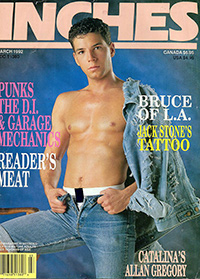
Inches' laudable editorial goal is to glorify sex with men who have enormous "members," but now, apparently, what one can do with one's larger than life organs may be strictly limited by the new self-imposed censorship which the Reaganite anti-porn activists have created.
The worst of the lot, another nameless travesty of apolitical desiccation, recently carried an endless interview with a no-talent, has-been comedienne. The burned out star has a remark highlighted about not getting bitter. On the very same and facing pages, tacky display ads invite your patronage of various call boy services ("reach out to the boys of summer").
Some time ago a publishing impresario of my acquaintance made a long private dinner speech to me about the Responsibilities of Gay Publishing. Those duties inherently involve a solid outreach to Just Plain Joe who goes to the bar once a week and who, even understandably, enjoys sex (in addition to the other good things of life).
There is a vast gay reading public out there. Unsurprisingly, some gay writers run around almost starving because they can't get an outlet for their work. Others, in order to get by financially, even take to writing straight sex erotica in an attempt to pay the bills! One wonders how the John Rechy's and Samuel M. Steward's survive in this atmosphere of neglect or just how the Isherwoods of our future will come of age.
As we've seen, many of these periodicals have a long, long way to grow: better pay for writers, more and better-edited copy, a broader range of copy content.
But these magazines are what Gay America is reading, my friends, and that's what enthralls and worries me.
Editor's note: this article originally appeared in a different form in Boston's Bay Windows.
